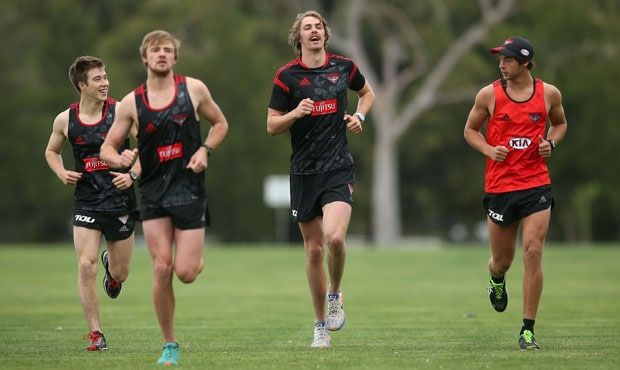The AFL’s football department tax shouldn’t be allowed to impact the most important and largest growth areas within our clubs. Philosophically clubs that work hard and have excellent systems in place should not be penalised. If they have to find room, then the last place I would be cutting is the learning and education areas - both on and off the field. Young men are met with many physical, mental and social challenges as they navigate their way through a tough game and they need to be appropriately developed so they can tackle these obstacles.
In Essendon’s premiership year of 2000 the club operated under one Development Coach - the late great Dean Bailey. It was about skill execution and decision-making. Even then, Bailey was ahead of his time.
I’m not sure I like the term ‘development’. It’s now clearly about education and learning - how young men learn and how coaches teach. Football clubs these days should have an education and learning department that includes experts in welfare, education and training, career development and of course game learning and skill acquisition. While teaching them how to play is obviously important, the training and education, and particularly these days, career direction should all come under one umbrella. Then it could be called the development of the whole person.
To this day the game still has players with five plus years’ experience coming out of the game without a qualification. Surely the greatest resource is the young drafted players and what the club can make of them. The days of a ‘development’ coach’s sole purpose being to ‘teach football’ is antiquated. If you teach and educate the whole person then you will get a better footballer. If the football department tax is to impact negatively, never let it impact in the education process of our young footballers.
Earlier this year I listened to Chairman Lindsay Tanner speak to the Essendon past players. He described how his personal priority would be player welfare, training and education to ensure players don't end up on the job scrapheap once their playing careers are finished. Gladly there will be no football department cutting in this area under Tanner. This is going to be very significant in the rebuilding of Essendon – looking after your kids.

The Bombers young stars are getting plenty of opportunities to develop their game this season.
Essendon’s development and welfare programs can be judged in the next 12-24 months through the two to four year players; Daniher, Edwards, Laverde, Fantasia, Langford, Zach Merrett, Jackson Merrett, Gleeson, Ashby, Ambrose, Kommer, McDonald-Tipungwuti, McKenna, Long and Hams. This should be the core of the Bombers next batch of 100 game players. At the moment there is a bit of everything in that group. Last week Essendon selected experienced players in Crowley, Simpkin and Polkinghorne. They probably deserved it. But interestingly there was no Kommer, Jackson Merrett, Ashby or Edwards. That group needs to get cracking.
Since the days of Dean Bailey most clubs across the AFL have beefed up their education and training departments to incorporate, on average, three to five coaches. Even recently some have been part-time and have been appointed on the basis of their experience and success in a specific position. That won’t work either. Thankfully nearly all clubs have full time departments in this critical area. I think the days should be well and truly gone where you appoint someone as a ‘development coach’ because they played 300 games. Can they teach? Do they know how young men learn?
Some clubs have a tiered system where coaches work with one of the senior assistants, for example ‘Development Stoppage Coach’. Other clubs work as a group and have a heavy involvement on the coaching of the VFL team. After all, they are looking to educate and improve the next batch of senior footballers. There are one on one sessions, group sessions, video analysis, game scenarios and tactical periodization (moments of the game).
But coaching and development isn’t about what you know. Every coach has experience and knowledge. It’s all about what the player (student) learns. It’s a bit like the classroom. Once we taught up the front of the class to 25 students and then gave them a test. Players, like students, all learn differently. There are visual learners, auditory (listeners), kinaesthetic learners (movement) and analysts (reader). So to be able to educate, a coach must know the learning style of his player.
For example, within the All Black rugby team in New Zealand, it seems many players tend to be dominant in the kinaesthetic sense. The players carry out physical movements - game scenarios - where learning takes place on the practice field. They are constantly working and practicing the ‘All-Black way’. It makes sense when you watch them - they are so well programmed.
The old approach was the instructional/prescriptive method. Here the coach is the expert, has all the answers and he tells the player what he has done, why he has done it incorrectly and what he needs to do to put it right. There was no attempt to find out what the player was thinking, why he took the option that he did and the nature of his reasoning. If the player (student) doesn’t understand then learning does not take place. I am convinced implicit learning (where players work things out for themselves, guided by their coach) is hugely more powerful than ‘telling’. Times have changed.
The priorities should be to profile your athlete, develop a personal learning and education plan on and off the field, install qualify staff as educators (as distinct from just coaches) and continue to invest money into the biggest growth area in AFL. With the 12 suspended players hopefully coming back bit-by-bit, its paramount Essendon develop its youngsters that can form the future of a very strong list.


